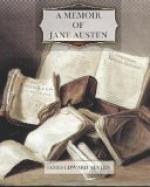any materials for a detailed life of my aunt; but
I have a distinct recollection of her person and character;
and perhaps many may take an interest in a delineation,
if any such can be drawn, of that prolific mind whence
sprung the Dashwoods and Bennets, the Bertrams and
Woodhouses, the Thorpes and Musgroves, who have been
admitted as familiar guests to the firesides of so
many families, and are known there as individually
and intimately as if they were living neighbours.
Many may care to know whether the moral rectitude,
the correct taste, and the warm affections with which
she invested her ideal characters, were really existing
in the native source whence those ideas flowed, and
were actually exhibited by her in the various relations
of life. I can indeed bear witness that there
was scarcely a charm in her most delightful characters
that was not a true reflection of her own sweet temper
and loving heart. I was young when we lost her;
but the impressions made on the young are deep, and
though in the course of fifty years I have forgotten
much, I have not forgotten that ‘Aunt Jane’
was the delight of all her nephews and nieces.
We did not think of her as being clever, still less
as being famous; but we valued her as one always kind,
sympathising, and amusing. To all this I am
a living witness, but whether I can sketch out such
a faint outline of this excellence as shall be perceptible
to others may be reasonably doubted. Aided,
however, by a few survivors {3} who knew her, I will
not refuse to make the attempt. I am the more
inclined to undertake the task from a conviction that,
however little I may have to tell, no one else is
left who could tell so much of her.
Jane Austen was born on December 16, 1775, at the
Parsonage House of Steventon in Hampshire. Her
father, the Rev. George Austen, was of a family long
established in the neighbourhood of Tenterden and Sevenoaks
in Kent. I believe that early in the seventeenth
century they were clothiers. Hasted, in his
history of Kent, says: ’The clothing business
was exercised by persons who possessed most of the
landed property in the Weald, insomuch that almost
all the ancient families of these parts, now of large
estates and genteel rank in life, and some of them
ennobled by titles, are sprung from ancestors who
have used this great staple manufacture, now almost
unknown here.’ In his list of these families
Hasted places the Austens, and he adds that these clothiers
’were usually called the Gray Coats of Kent;
and were a body so numerous and united that at county
elections whoever had their vote and interest was almost
certain of being elected.’ The family still
retains a badge of this origin; for their livery is
of that peculiar mixture of light blue and white called
Kentish gray, which forms the facings of the Kentish
militia.




